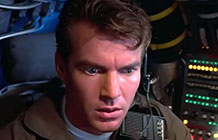|
|
|
|
Innerspace
|
 |
|
Innerspace causes me to seriously wonder whether
there is anything productive in the Steven Spielberg/Joe Dante partnership
beyond the one-off wonder of Gremlins (1984) – a film that is, after
all, as much anti-Spielberg as it is summarising of his art and craft. Dante
seems now very much the loser, the subordinate, in this relation. Innerspace is a bit of sad mess – as far from the radical, cheeky, innovative potential of
Dante’s filmmaking as can be imagined.
After Gremlins, Dante spoke of his wish to go further into the “weird”,
unconventional aspects of film fantasy (Prevue, no. 60, July-Aug ’85).
Dante aficionados know precisely what brand of weird he’s talking about: early Mad magazine, the Warner Bros cartoons of Tex Avery or Chuck Jones, unrestrained
Jerry Lewis. Innerpsace held out the delicious
promise of being the ultimate Dante inferno: a no-holds barred live-action
cartoon about the human body both inside and out, and the transgression of its
limits.
So
much for high hopes. Innerspace takes over the old Fantastic Voyage (1966) premise of one person in a spacecraft, Lt. Tuck Pendleton (Dennis Quaid),
miniaturised inside another person, Jack Putter (Martin Short). Making sense of
even the basic fictional premise beyond this point poses considerable problems.
It leaps all over the place, trying out one possible Tuck-Jack relation and
then another.
For
the most part, it’s not a film about the body at all – except for one freakish,
delirious moment of corporeal transformation – but more simply one about conscience, with Tuck acting as Jack’s
Ego or Id (hey, don’t look at my girlfriend like that!). Whenever the plot
requires it, however, Tuck is suddenly able to completely program and
manipulate Jack’s body (pumping the adrenalin level on his computer board!).
Throughout, Innerspace goes to strenuous lengths – and here one must surely suspect the hand of Spielberg
– to avoid anything even slightly icky, slimy, anal or erotic inside the
landscape of the human body: gastric acid is employed as the most sanitised
backdrop of abjection for the big, action scene.
As
sometimes happens in Dante, attempts at conventional character pathos creak badly
(his heart rarely seems to be in it, and the ironic distance necessary doesn’t
always manage to get installed) – and this is a film which starts on an interminable
attempt to set up Tuck’s rough-but-solid hero status along with the general
emotional co-ordinates of the story (fidelity, trust, integrity,
self-discovery, compromise …). None of this, I’d like to say, is Dante’s
business – and he probably knows it.
The
other big moment of the film – when Tuck enters the body of his girlfriend,
Lydia (Meg Ryan), via the transitional passage of Jack’s mouth and discovers there
the foetus of his yet-unborn child – would be, if heartfelt, extraordinary;
Dante seems to throw it away out of acute embarrassment, leaving half the
audience scratching its collective head as to what just actually happened.
Innerspace is full
of painfully marginal notations for the film Dante obviously craved to make: a
laboratory rabbit named Bugs; a cameo by Chuck Jones; an elaborate but wasted
gag involving villains reduced to pigmy size. He eventually settles for a few nice
touches that are more Frank Tashlin than Tex Avery, such as the penultimate
moment when Jack closes three sub-plots in seven words.
But
these jokes amount to cold comfort. Maybe Dante needs to get back together with
some former colleagues: Roger Corman, John Sayles,
Allan Arkush …
MORE Dante: Looney Tunes: Back in Action, Matinee, Explorers © Adrian Martin November 1987 |
![]()